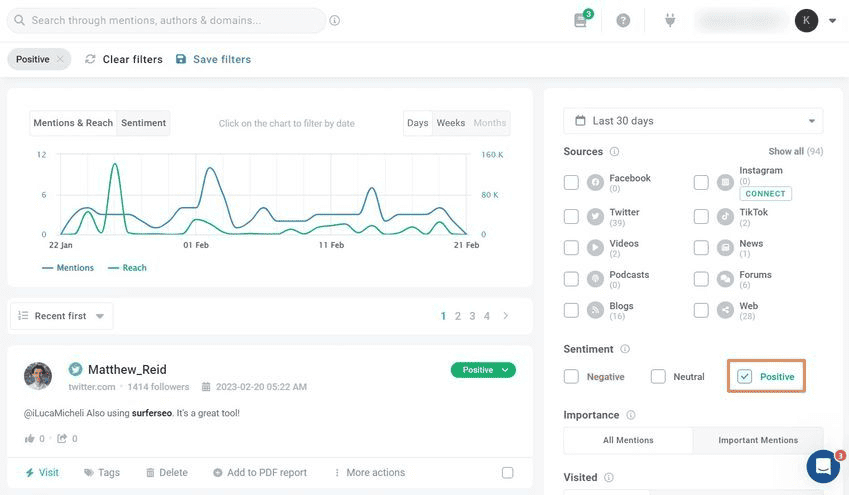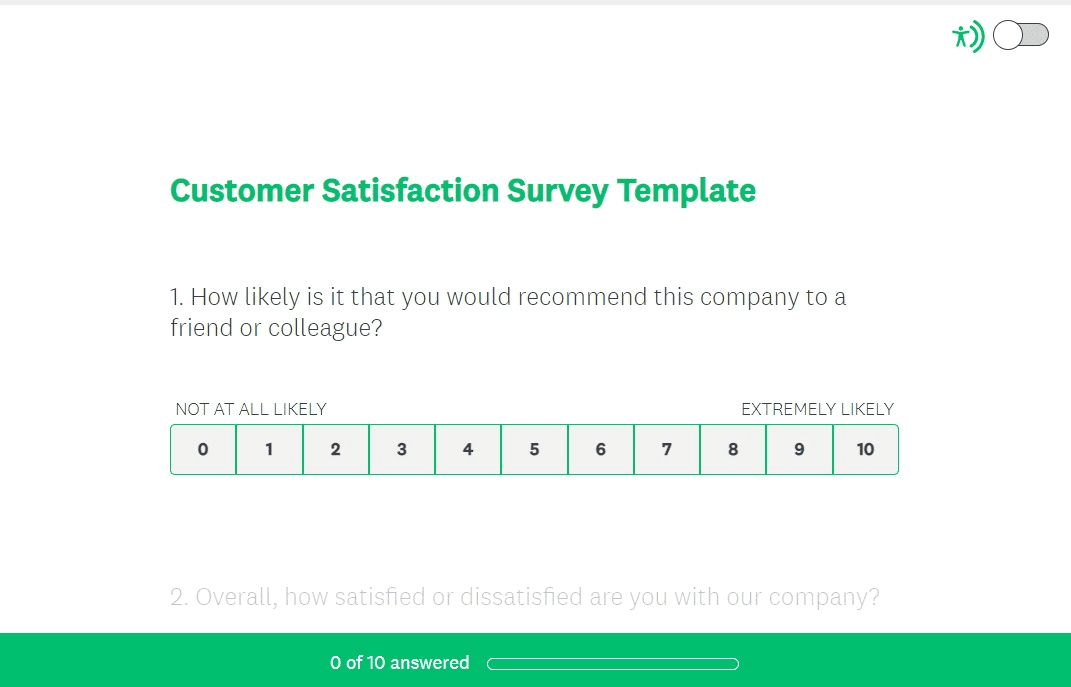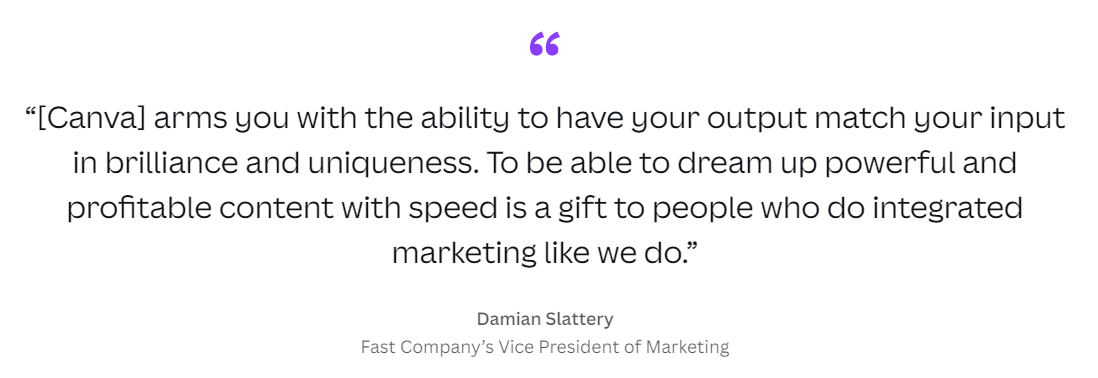How to Get Customer Testimonials? Extremely Easy Method
Table of contents
Are you looking to collect testimonials about your brand? You’re in the right place! I will show you how to find customer satisfaction quotes with no effort. Let’s dive in!
In today’s highly competitive market, every business needs to find ways to stand out and capture the attention of potential customers.
Positive customer testimonials are great for doing that. They will help you to:
- Build trust
- Demonstrate value
- Increases conversions
- Enhances brand reputation
- Build customer loyalty
- Create engaging content
So, let’s figure out how to find positive customer quotes.
How to gather testimonials
01 Use media monitoring
The easiest and most effortless way to get positive customer quotes is to use a tool that finds them for you.
How does it work?
The tool collects public online mentions of keywords you want to track. It can be your brand or product name, or any other keyword.
After gathering the data, the media monitoring tool selects positive mentions.
What’s more, you can filter negative mentions to find out what customers don’t like. This feature will help you to detect customers’ perceptions of your brand or product.

To start collecting quotes, you need to set up a monitoring project. Then the tool will do the job for you.
Brand24 is the tool that collects positive customer quotes. Try it for free!
This method is quick and easy. Here are more benefits:
- Real-time feedback: Media monitoring tools allow you to track what customers say about products or services in real-time.
- Honest opinions: People that share their thoughts and feelings online are more likely, to be honest than someone who fulfills the survey hoping for discounts or other benefits.
- Cost-effective: Compared to other forms of market research, media monitoring tools can be a more cost-effective way to collect customer feedback and insights.
02 Monitor mentions
The second way to find quotes posted by satisfied customers is also related to media monitoring.
You can sort mentions by importance, sentiment, source, and domain in the Mention tab. So if you need to find customer satisfaction quotes from Twitter, TikTok, news, podcasts, or other sources, it is possible.

It is a more time-consuming method than the previous one, but you will learn about customer experience and expectations.
Also, it will help you detect loyal customers that often mention your brand. They might be a great partner for creating a case study, video testimonial, or posting a positive opinion on review websites.
Thanks to sentiment analysis, you can find the most unhappy customers and detect why they’ve posted a negative mention.
Furthermore, competitor monitoring can provide insight into what customers like or dislike about their products or services, which can inform your business strategy and help you improve your own product.
Overall, thanks to monitoring online mentions, you can identify positive customer feedback that can be used as customer quotes.
Brand24 is the tool that collects positive customer quotes. Try it for free!
How do you convince customers to leave opinions on review websites, such as G2 or Cappterra?
Convincing customers to leave online reviews can be challenging, but it’s definitely doable. The key is to ensure you’re targeting the right customers. Identify people with whom you have a strong relationship. You can also contact brand ambassadors who are well acquainted with the features and benefits of your product.
Once you’ve identified potential reviewers for your product or service, incentivizing them for their time will likely increase engagement. Offering discounts, gift cards, etc., is a well-proven tactic.
Alicja Mękarska
Partner Marketing Manager
03 Conduct a survey
Surveys can be a good choice to get customer quotes, especially when they are designed well and conducted properly.
You can distribute them via email, social media, or other online platforms, making it easy to reach a large number of customers.
They can provide you with quantitative data and insights into customer satisfaction, experiences, and perceptions.
However, surveys also have limitations and challenges, including:
- Low response rates
- Biased responses
- Survey fatigue
Offering a reward for completing a survey can effectively increase response rates and motivate people to participate.
However, there is a potential risk that the reward may influence respondents to answer the questions.
Respondents might think that a positive opinion might increase their chances of receiving the bonus. As a result, you might receive insincere and flattering feedback.
To address these challenges, you can use various strategies to increase response rates, minimize bias, and gain more meaningful insights from surveys. This may include:
- Keep the survey short and focused. Long surveys can be overwhelming and lead to drop-off, so it’s important to keep the survey short and focused on specific questions.
- Offer anonymity and confidentiality. Customers may be more likely to provide honest feedback if they feel their responses are anonymous and confidential.
- Avoid incentives. Offering incentives like discounts or free products may incentivize customers to participate, but it may also lead to biased feedback.
- Test the survey. Before sending out the survey, test it with a small sample of customers to identify any issues or concerns.

04 Ask for feedback
Every business has a customer base. You can message a well-satisfied customer to gain a quote. It’s a great way to understand customers’ perceptions, but it’s time-consuming.
One of the biggest challenges of asking for feedback is getting customers to actually provide it. Some customers may be too busy or not interested in giving feedback, which can result in low response rates.
Here are some tips on how to get customer satisfaction quotes:
- Choose a loyal customer: People who have been using your services or products for years are more likely to give you customer feedback.
- Make it easy to provide feedback: Customers are more likely to provide feedback if it is easy to do so. Use a simple feedback form or survey that is easy to complete and provides clear instructions on submitting the feedback.
- Follow up: After receiving feedback, follow up with customers to thank them for their time and let them know how you plan to address their feedback. This shows that you treat customers seriously and listen to their feedback.
Probably, you’ll gain valuable feedback if you have great customer service and ensure an excellent customer experience. Also, take a look at the best customer feedback tools.
Find positive testimonials. Sign-up for a free trial!
How do you convince customers to create the case study?
The key to convincing customers to create a case study is to emphasize the value that it offers to them. Illustrate the advantages of partnering with your business, such as any extra perks (e.g., discounts or extra services). Explain how case studies demonstrate the value of their product or service, as well as how it can be used as a marketing tool to reach a wider audience and establish a positive reputation.
Be sure to provide a timeline and explain the step-by-step process that customers need to follow in order to create the case study. Make it clear that you are committed to the project and will be involved every step of the way since this will create trust and reliability with potential customers and help to persuade them to create the case study.
Also, if you don’t have a current connection with the customer, see if any of your colleagues do. Ask them to send an email with the proposal, and if the customer agrees, ask for an introduction. Those simple measures should do the trick!
Waleria Pągowska
Product Marketing Specialist at Brand24
05 Testimonial request form
What is a testimonial page?
A testimonial page is a dedicated section on a website where businesses showcase the positive experiences and feedback from their clients or customers. It often features client testimonials in various formats, such as written statements, video testimonials, or ratings from niche review sites. A well-crafted testimonials page can effectively build trust, credibility, and social proof, ultimately leading to increased conversions and customer loyalty.
A good testimonial page typically has the following characteristics:
- Variety of formats: Including a mix of written testimonials and video testimonials makes the page more engaging and caters to different preferences among potential customers.
- Authenticity: Genuine, unscripted testimonials from real clients resonate more with prospects, as they can relate to the experiences shared.
- Relevance: Testimonials that address specific pain points or benefits of the product or service are more likely to be persuasive.
- Organization: Grouping testimonials by product or service, or by the type of customer, can make it easier for potential clients to find relevant information.
- Integration with niche review sites: Showcasing ratings and reviews from trusted industry-specific platforms can enhance credibility and social proof.
On the other hand, a bad testimonial page might have the following issues:
- Lack of variety: Featuring only written testimonials or generic statements that don’t address specific benefits or experiences can make the page less engaging.
- Overly polished or scripted testimonials: These can come across as inauthentic and may make potential customers skeptical.
- Irrelevant or outdated content: Testimonials that don’t address current products or services, or that discuss features that have since been improved, can be less persuasive.
- Poor organization or design: An unattractive or cluttered layout can detract from the impact of the testimonials.
To improve a testimonial page, consider taking the following steps:
- Request testimonials: Reach out to satisfied clients using a testimonial request template to encourage them to share their positive experiences. Make the process easy and convenient for them, for example, by providing a simple form or link to a review site.
- Create a separate testimonial page: Dedicate a specific page to testimonials, ensuring it is easy to find and navigate from the main website.
- Update content regularly: Keep the testimonial page fresh and relevant by adding new testimonials, removing outdated ones, and updating the design as needed.
- Optimize for SEO: Use relevant keywords and optimize the testimonial page for search engines to increase visibility and attract potential customers.
Where to place customer testimonials?
It’s best to put quotes in places where potential customers are most likely to see them, such as:
Website homepage
Placing customer testimonials on the homepage of your website is a great way to showcase positive feedback and build trust with potential customers.
It’s a great way to highlight the popularity of your product or service, build social proof, and encourage visitors to take action.

Product pages
Including customer testimonials on product pages can provide social proof and encourage customers to purchase.
Customer success stories specific to each product can help showcase that product’s unique benefits and features. It’s also a great way to highlight customer experience.

Landing pages
If you are running a specific marketing campaign or promoting a particular offer, think about including customer testimonials on the landing page for that campaign. This can help reinforce the value of the offer and increase conversion rates.
Consider featuring a quote that summarizes your offer’s benefits or highlights an impressive result.

Testimonial request forms
Including customer testimonials on sign-up forms can be a great way to build trust and encourage potential customers to take action.
By strategically placing testimonials and using different quotes, you can create a more effective sign-up form to drive sales for the entire company.

Email marketing
Including customer testimonials in your email marketing campaigns can help boost open and click-through rates.
Social media
Sharing customer testimonials on social media can help increase engagement and catch your audience’s attention. Consider sharing a quote as a graphic or featuring a customer testimonial in a post.
Thanks to media monitoring, you can easily look for quotes written by a satisfied customer and post them on your social media.

Advertisements
Including customer testimonials in paid advertisements can help increase the effectiveness of your marketing campaigns.
Customer quotes in your paid advertising copy can help add a human touch and build credibility with potential customers. Including a statistic or data point that highlights the popularity of your product or service will show that you run a successful business.

Find positive customer quotes. Sign-up for a free trial!
Conclusion
Customer satisfaction quotes can boost your business growth. In fact, many successful businesses use them to boost their traffic, sales, and marketing goals.
Here are some key takeaways:
- Customer satisfaction quotes can build trust and credibility, differentiate your brand, improve conversion rates, boost word-of-mouth marketing, illustrate the customer’s perception, and guide product development.
- Media monitoring tools easily find customer quotes and will help you measure customer satisfaction.
- Surveys and asking for feedback are good ways to get customer satisfaction quotes, but they are time-consuming and require lots of effort.
By using the strategies outlined in this article to gather happy customer quotes, you can build social proof and demonstrate the value of your product or service to potential customers.
So why not give it a try and start collecting happy customer quotes today?
With a little effort and some great feedback, you can take your marketing and business growth to the next level. Try Brand24 for free!
FAQ
Can we ask clients for testimonials?
Yes, it is acceptable to ask clients for written or video testimonial. Make sure to approach them with a polite and professional tone, and provide an easy way for them to share their experiences, such as a testimonial request template or a link to a review site.
How do I get testimonials for a new product?
To obtain more testimonials for a new product, offer the product to a select group of customers, influencers, or industry experts and request their feedback. Encourage them to share their experiences, which can then be showcased on your website or social media channels.
Do I need permission to use customer testimonials?
Yes, it is essential to obtain permission from customers before using their testimonials in marketing materials. This ensures you respect their privacy and adhere to any applicable laws or regulations. When requesting a testimonial, clearly communicate your intentions to use it for marketing purposes and obtain their written consent. This helps protect both your business and the customer and fosters a relationship built on trust and transparency.
What is the difference between a review and a testimonial?
The main difference between a review and a testimonial lies in their purpose and the way they are presented.
A review is an evaluation or assessment of a product, service, or business, usually provided by customers who have used the product or service. Reviews are often found on third-party platforms or niche review sites, and they can be both positive and negative, offering a balanced perspective to potential customers.
A testimonial, on the other hand, is a positive statement or endorsement provided by a satisfied customer, praising a product, service, or business. Testimonials are typically used by businesses in their marketing materials or displayed on their website to build trust, and credibility, and showcase their success. Great testimonials are genuine, specific, and relatable, addressing the unique features or benefits that made the customer’s experience exceptional.
Related articles

![The 15 Best AI Sentiment Analysis Tools [Tested in 2025]](https://brand24.com/blog/app/uploads/2021/08/The-best-AI-sentiment-analysis-tools-in-2021.png)

